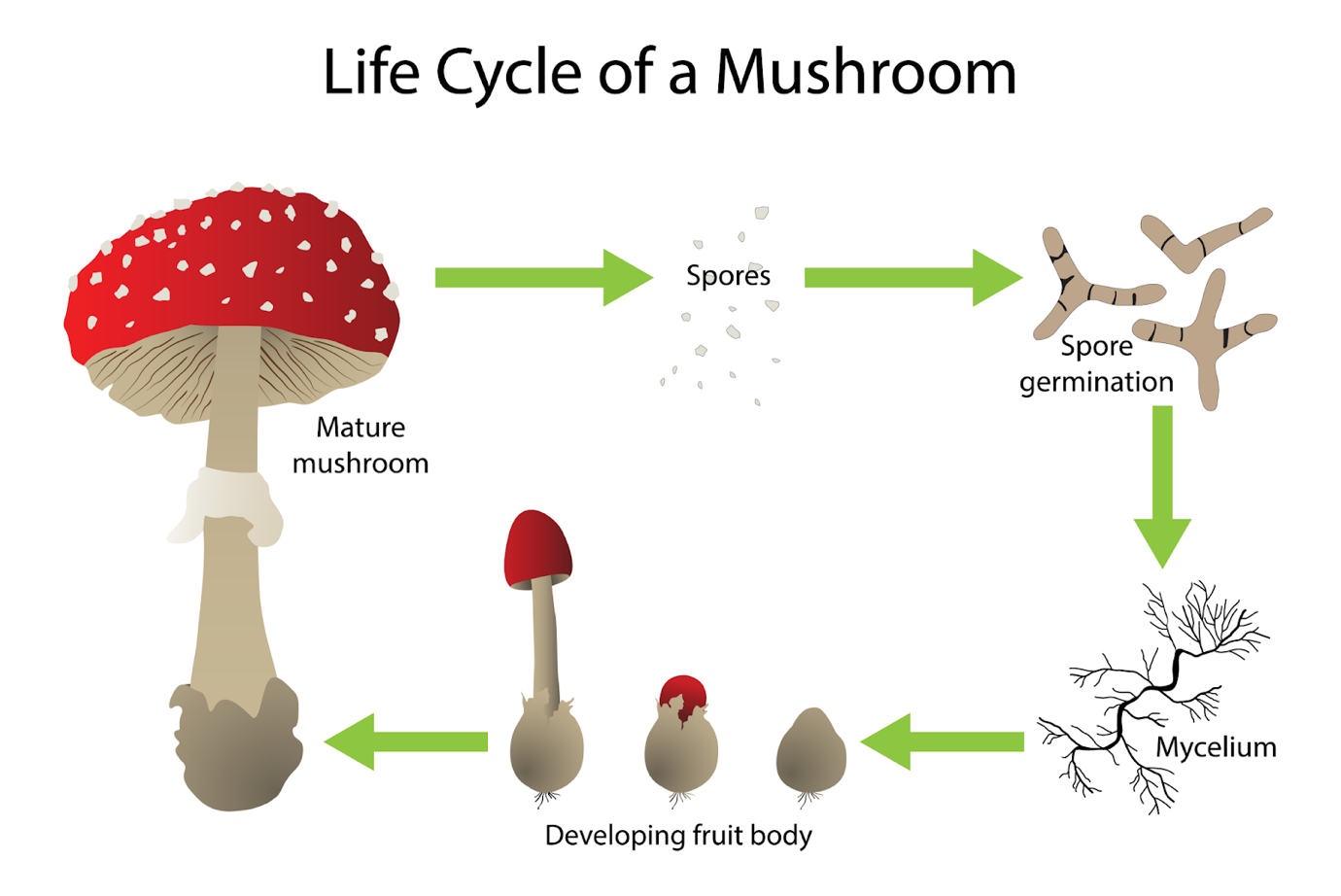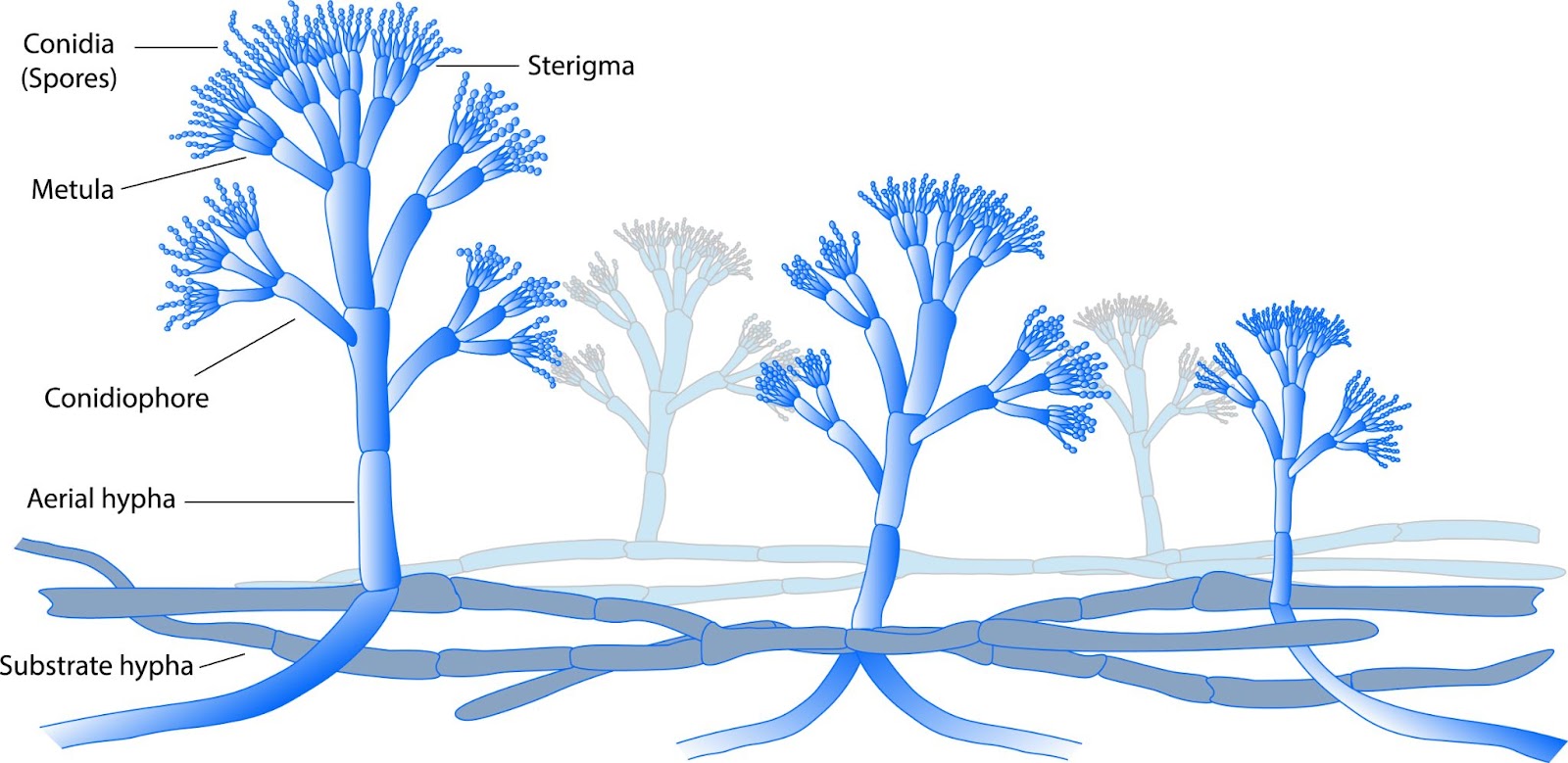What is fungi in biology?
Along with terrestrial plants and animals, fungi are eukaryotes with a huge range of body designs and are one of the main evolutionary lineages to occupy land. Although there are roughly 100,000 known species of fungi, there are about 1.5 million different types of fungi on Earth. Edible mushrooms, yeasts, black mold, and the producer of the antibiotic penicillin, Penicillium notatum, are all fungi. And currently, the largest living organism on Earth’s surface is a fungus.
Although humans have used yeasts and mushrooms since prehistoric times, until recently, the biology of fungi was poorly understood. Fungi can be multicellular or unicellular; however, they all share the following characteristics:
- Fungi are eukaryotic organisms; they have true nuclei that are protected by membranes.
- The vascular system is absent in them. There is no Xylem or Phloem.
- The cell walls of fungi are made of chitin (plants also have cell walls, but animals have no cell walls).
- Fungi do not have an embryonic stage.
- Typically, they are not mobile.
- The phenomenon of altered generation is seen in fungi. Both haploid and diploid stages are present.
- Since fungi lack the chlorophyll pigments found in chloroplasts in plant cells—which are essential for photosynthesis—they are achlorophyllous.
- The vegetative body of a fungus might be made up of microscopic threads called hyphae or it can be unicellular.
- Hyphae can expand and develop into a network known as mycelium.
- As a unicellular fungus, yeasts cannot form hyphae.
 Along with terrestrial plants and animals, fungi are eukaryotes with a huge range of body designs and are one of the main evolutionary lineages to occupy land. Although there are roughly 100,000 known species of fungi, there are about 1.5 million different types of fungi on Earth. Edible mushrooms, yeasts, black mold, and the producer of the antibiotic penicillin, Penicillium notatum, are all fungi. And currently, the largest living organism on Earth’s surface is a fungus.
Along with terrestrial plants and animals, fungi are eukaryotes with a huge range of body designs and are one of the main evolutionary lineages to occupy land. Although there are roughly 100,000 known species of fungi, there are about 1.5 million different types of fungi on Earth. Edible mushrooms, yeasts, black mold, and the producer of the antibiotic penicillin, Penicillium notatum, are all fungi. And currently, the largest living organism on Earth’s surface is a fungus.
Penicillium is an example of fungi:

Fungi in Biology: Characteristics, Types, and Importance
Introduction
In the study of biology, organisms are classified into different kingdoms based on their cell structure, mode of nutrition, and reproduction. One of the most fascinating and diverse groups of organisms is the Kingdom Fungi. Fungi are not plants or animals, but they share characteristics with both, making them unique in the tree of life. From the mushrooms we eat to the yeast used in bread and beer production, and even the molds that spoil food, fungi are everywhere around us. They play vital roles in ecosystems, industries, medicine, and agriculture, while also being responsible for some serious diseases. This article explores fungi in biology, covering their structure, classification, reproduction, ecological roles, and importance.
What Are Fungi?
Fungi are eukaryotic organisms that include yeasts, molds, mildews, and mushrooms. They are heterotrophic, meaning they cannot produce their own food through photosynthesis like plants. Instead, fungi absorb nutrients from dead matter, living hosts, or through symbiotic associations.
Key features of fungi:
-
Eukaryotic cell structure with nucleus and organelles.
-
Cell wall made of chitin (not cellulose like plants).
-
Lack of chlorophyll, so they cannot photosynthesize.
-
Nutrition obtained by absorption through extracellular digestion.
-
Reproduce by forming spores (asexual or sexual).
Structure of Fungi
1. Hyphae
Fungi are made up of fine, thread-like structures called hyphae. These hyphae grow and branch, forming a network.
2. Mycelium
A mass of hyphae forms the mycelium, which is the main body of the fungus. Mycelium spreads through the substrate (soil, wood, or host body) to absorb nutrients.
3. Fruiting Body
In many fungi, the reproductive structure that appears above ground (like a mushroom) is called the fruiting body. It produces and disperses spores.
Habitat of Fungi
Fungi are found in diverse environments:
-
Soil – where they decompose organic matter.
-
Decaying matter – such as fallen leaves, wood, or dung.
-
Water bodies – some fungi are aquatic.
-
Inside living organisms – as parasites or symbionts.
-
Extreme conditions – some fungi can even survive in acidic or salty environments.
Modes of Nutrition in Fungi
-
Saprophytic Fungi – Obtain food from dead and decaying matter. (Example: Rhizopus on bread)
-
Parasitic Fungi – Absorb nutrients from living hosts, often causing disease. (Example: Candida in humans, rust fungi in plants)
-
Symbiotic Fungi – Live in mutually beneficial associations. Examples:
-
Lichens – a symbiosis of fungi and algae.
-
Mycorrhizae – fungi associated with plant roots, helping in nutrient absorption.
-
Reproduction in Fungi
Fungi reproduce both asexually and sexually, depending on species and environmental conditions.
Asexual Reproduction
-
By spores (conidia, sporangiospores).
-
By fragmentation (breaking of mycelium).
-
By budding (common in yeasts).
Sexual Reproduction
-
Involves fusion of specialized sexual structures.
-
Produces zygospores, ascospores, or basidiospores depending on the group.
Classification of Fungi
Fungi are classified into several groups based on reproduction and structure:
-
Zygomycota (Zygomycetes)
-
Example: Rhizopus (bread mold).
-
Reproduce with zygospores.
-
-
Ascomycota (Sac Fungi)
-
Example: Saccharomyces (yeast), Aspergillus.
-
Produce spores in sac-like structures called asci.
-
-
Basidiomycota (Club Fungi)
-
Example: Mushrooms, puffballs.
-
Spores produced on club-shaped structures called basidia.
-
-
Chytridiomycota (Chytrids)
-
Aquatic fungi with motile spores.
-
Example: Batrachochytrium (causes disease in amphibians).
-
-
Glomeromycota
-
Fungi that form mycorrhizal associations with plants.
-
Crucial for plant nutrient uptake.
-
Importance of Fungi
1. Ecological Importance
-
Decomposers: Break down dead organisms, recycling nutrients into the ecosystem.
-
Symbiotic relationships: Lichens and mycorrhizae help ecosystems thrive.
2. Industrial Importance
-
Food industry: Yeasts used in baking, brewing, and winemaking.
-
Fermentation: Production of soy sauce, cheese, and other fermented foods.
-
Biotechnology: Fungi used in enzyme and organic acid production.
3. Medical Importance
-
Antibiotics: Penicillium produces penicillin, the first antibiotic.
-
Other drugs: Fungi are sources of statins, immunosuppressants, and more.
-
Pathogens: Some fungi cause diseases (mycoses) in humans, such as athlete’s foot and candidiasis.
4. Agricultural Importance
-
Beneficial fungi: Mycorrhizae improve plant growth.
-
Harmful fungi: Cause crop diseases like rusts, smuts, and blights, leading to major agricultural losses.
Examples of Fungi in Daily Life
-
Bread mold (Rhizopus) – grows on stale bread.
-
Yeast (Saccharomyces) – used in baking and brewing.
-
Mushrooms (Agaricus) – edible fungi.
-
Truffles and morels – highly prized edible fungi.
-
Candida – causes infections in humans.
-
Aspergillus – used in industry, but also a pathogen.
Fungi and Humans
Humans have a close relationship with fungi:
-
Positive side: Food, medicine, fermentation, agriculture.
-
Negative side: Food spoilage, diseases, crop destruction.
The balance of fungi in ecosystems is crucial—while some species benefit us greatly, others present challenges.
Conclusion
Fungi in biology represent one of the most versatile and essential kingdoms of life. They are neither plants nor animals but occupy a unique position with features of both. From decomposing dead matter to supporting plant growth, producing medicines, and contributing to food production, fungi are indispensable to life on Earth. At the same time, they can also be harmful, causing diseases in plants, animals, and humans. Understanding fungi is therefore crucial not only in biology but also in agriculture, medicine, and industry.